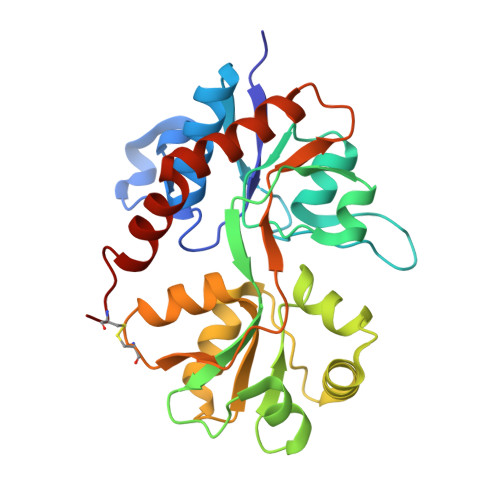TAK-137, an AMPA-R potentiator with little agonistic effect, has a wide therapeutic window.
Kunugi, A., Tanaka, M., Suzuki, A., Tajima, Y., Suzuki, N., Suzuki, M., Nakamura, S., Kuno, H., Yokota, A., Sogabe, S., Kosugi, Y., Awasaki, Y., Kaku, T., Kimura, H.(2019) Neuropsychopharmacology 44: 961-970
- PubMed: 30209408
- DOI: https://doi.org/10.1038/s41386-018-0213-7
- Primary Citation of Related Structures:
5ZG0, 5ZG1, 5ZG2, 5ZG3 - PubMed Abstract:
Activation of α-amino-3-hydroxy-5-methyl-4-isoxazole-propionic acid receptor (AMPA-R) is a promising strategy to treat psychiatric and neurological diseases if issues of bell-shaped response and narrow safety margin against seizure can be overcome. Here, we show that structural interference at Ser743 in AMPA-R is a key to lower the agonistic effect of AMPA-R potentiators containing dihydropyridothiadiazine 2,2-dioxides skeleton. With this structural insight, TAK-137, 9-(4-phenoxyphenyl)-3,4-dihydropyrido[2,1-c][1,2,4]thiadiazine 2,2-dioxide, was discovered as a novel AMPA-R potentiator with a lower agonistic effect than an AMPA-R potentiator LY451646 ((R)-N-(2-(4'-cyanobiphenyl-4-yl)propyl)propane-2-sulfonamide) in rat primary neurons. TAK-137 induced brain-derived neurotrophic factor in neurons in rodents and potently improved cognition in both rats and monkeys. Compared to LY451646, TAK-137 had a wider safety margin against seizure in rats. TAK-137 enhanced neural progenitor proliferation over a broader range of doses in rodents. Thus, TAK-137 is a promising AMPA-R potentiator with potent procognitive effects and lower risks of bell-shaped response and seizure. These data may open the door for the development of AMPA-R potentiators as therapeutic drugs for psychiatric and neurological diseases.
- Neuroscience Drug Discovery Unit, Research, Takeda Pharmaceutical Company Limited, Fujisawa, Japan.
Organizational Affiliation:




















